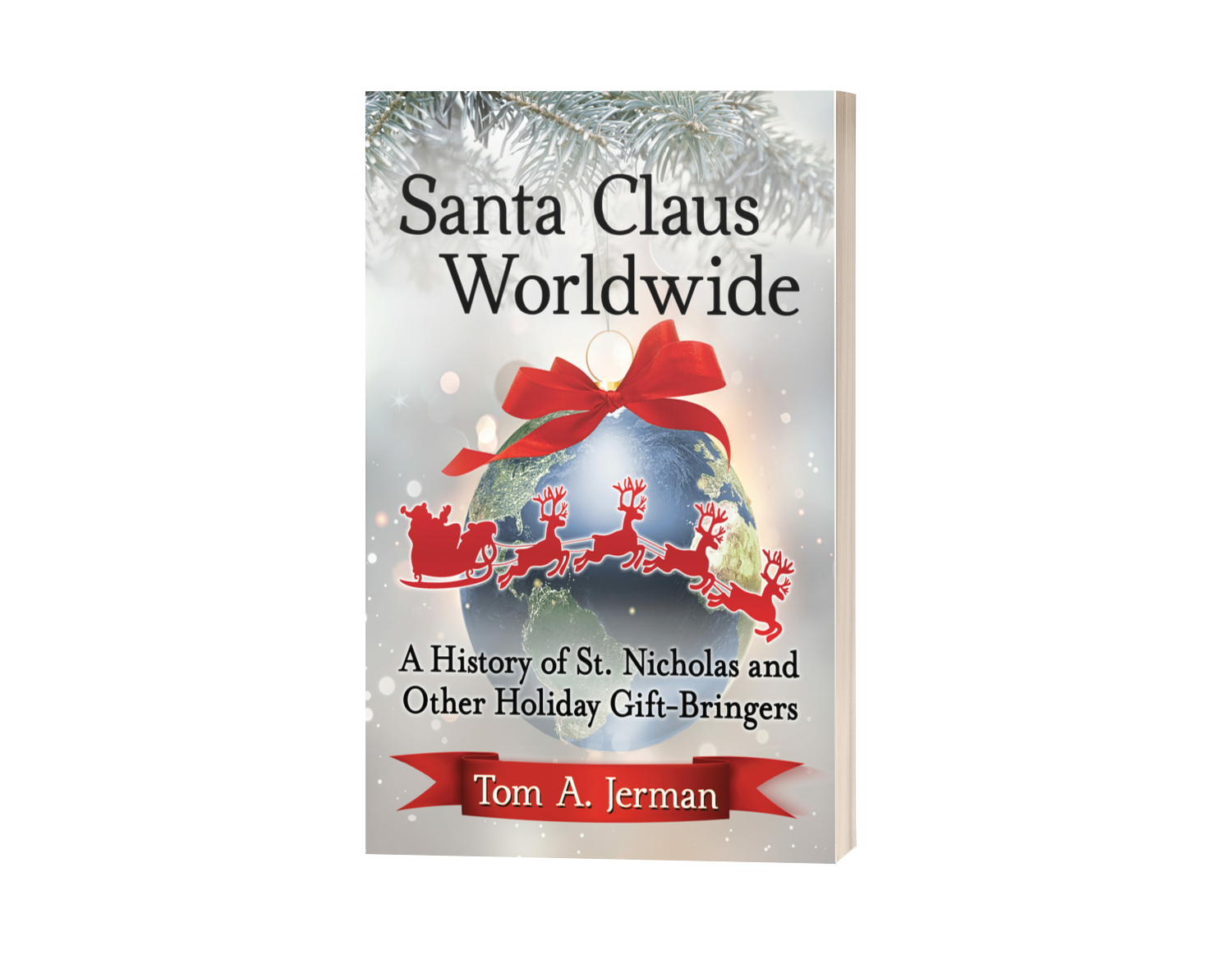







A Collection of Santas
Santa Claus Worldwide: A History of St. Nicholas and Other Holiday Gift-Bringers is a comprehensive history of the world’s midwinter gift-givers, showcasing the extreme diversity in their depictions as well as the many traits and functions these characters share. It tracks the evolution of these figures from the tribal priests who presided over winter solstice celebrations thousands of years before the birth of Christ, to Christian notables like St. Martin and St. Nicholas, to a variety of secular figures who emerged throughout Europe following the Protestant Reformation. Finally, it explains how an untitled poem by a wealthy New Yorker in 1822 gradually created an enduring tradition in which American children awake early on Christmas morning to see what Santa brought.
Although the names, appearance, attire and gift-giving practices of the world’s winter solstice gift-givers differ greatly, they are all recognizable as Santa, the personification of the Christmas and Winter Solstice festivals worldwide. Despite efforts to eliminate him by groups as diverse as the Puritans of seventeenth century New England, the Communist Party of the twentieth century Soviet Union and the government of Nazi Germany, Santa has survived and prospered, becoming one of the best known and most beloved figures in the world. The history of how Santa developed, however, has often been ignored, inaccurately conflated with the legend of St. Nicholas, fabricated under the guise of children’s stories or historical fiction, and, in one particularly significant case, subject to a significant error by one of the nation’s leading experts on St. Nicholas that has gone unnoticed for seventy years.
The product of years of exhaustive historical research, Santa Claus Worldwide is the first legitimate history of Santa Claus in more than a decade, and the first history in more than a hundred years to provide a comprehensive look at the Yuletide gift-givers throughout the world.
- This book corrects the conventional wisdom that the “original Santa Claus” was a real person, the fourth-century bishop known as St. Nicholas of Myra, debunking the oft-repeated claim that “Santa Claus” is merely the American name for St. Nicholas. While St. Nicholas had an important role in the development of Santa, he was neither the first version of Santa Claus nor the immediate predecessor of the American version.
- It was Roman gods like Saturn who presided over Winter Solstice ceremonies, which were converted into the earliest “Christmas” festivals after the Romans converted to Christianity during the fourth century, the Germanic gods Odin, Thor and Berchta who originally performed the role of Santa Claus, flying through the air on an assortment of animals or vehicles, landing on roofs and entering homes through the chimney, and leaving gifts for good children and punishments for bad ones.
- After northern Europe was Christianized during the Middle Ages, Catholic missionaries designated St. Nicholas as Yule gift-giver in lieu of the Germanic pagan gods. St. Nicholas was selected, however, only because his feast day, December 6, happened to coincide with the Germanic Yule festivities.
- This book also corrects a significant inaccuracy perpetrated in 1953 by an eminent Berkeley historian, Charles W. Jones, and adopted without question in more than two dozen historians since then, that American author Washington Irving created, in effect, the American Santa Claus. Jones’ theory—that Irving’s History of New York, first published in 1809, caused the legend of St. Nicholas to “spread like a plague” in New York during 1810—was based on the assumption that materials about St. Nicholas were included in the 1809 edition of Irving’s book. By comparing the 1809 and 1812 editions of Irving’s book, however, it is evidence that the critical materials were not included until the 1812 edition of Irving’s book, a previously unnoticed fact that completely undermines Jones’ theory (and the numerous histories that have relied on it).
- In fact, the original American Santa was the shabby, unkempt, secular gift-givers known by two dozen different names in Germany who immigrated to America with German children during the early nineteenth century. One of them, Pelznickel (“Nicholas in furs”), became known as Belsnickle in Pennsylvania while another, Christkindl (“Christ child”), became known as Kriss Kringle.
- Likewise, the name “Santa Claus” was not merely the American pronunciation of St. Nicholas. The name “Santa Claus,” and a number of close variants, were being used in Germany to describe the Yule gift-giver, and by 1813 a name pronounced as “Santiclaws” was already being used by children in New York–presumably, German immigrants–to describe essentially the same Yule gift-giver known as Belsnickel and Kriss Kringle in Pennsylvania.
The name “Santeclaus,” the bearded German gift-giver who descended down the chimney and left gifts in stockings hung out on Christmas, and a new element–a sleigh pulled by a flying reindeer–were united in 1821 by publisher William B. Gilley in a children’s book called The Children’s Friend: Part III A New-Year’s Present to the Little Ones from Five to Twelve. In 1822, Clement C. Moore, a neighbor and customer of Gilley, wrote a poem for his children based on Gilley’s book. Although the book disappeared from public knowledge until it was rediscovered roughly a hundred and twenty years later, the story lived on in Moore’s poem, “The Night Before Christmas.
